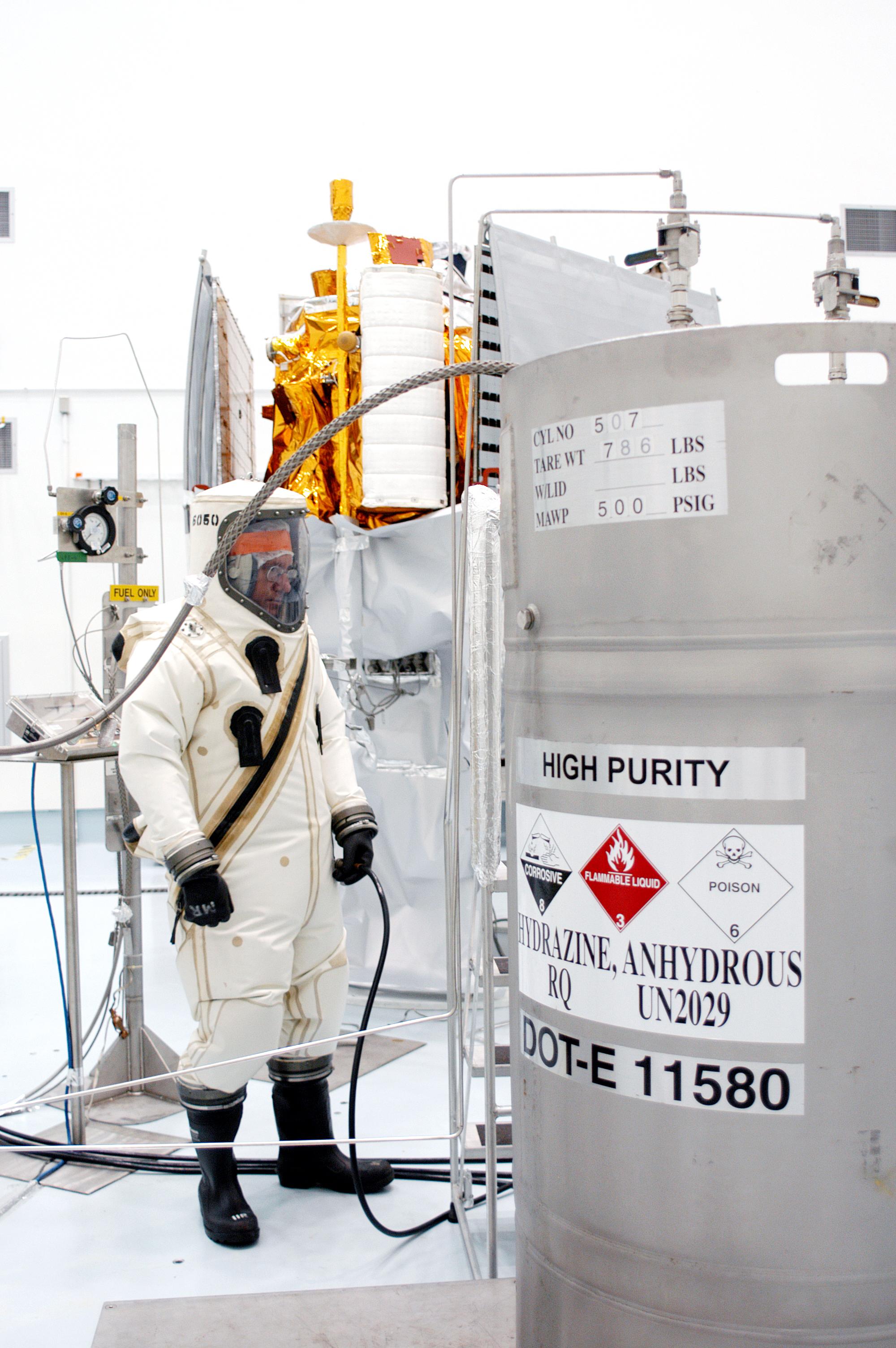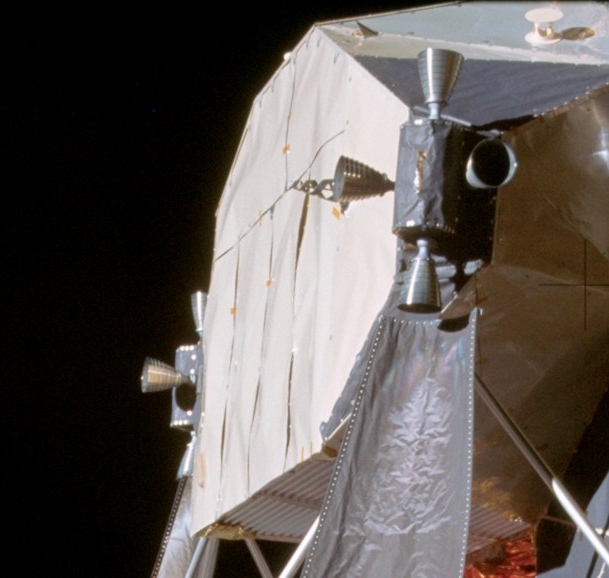|
Hypergol Maintenance Facility
Hypergol Maintenance Facility (HMF) is a rocket fuel and engine center located in an isolated location in the Kennedy Space Center industrial area. It was constructed in 1964 to support the Apollo program and upgraded in 1985 to support the Space Shuttle program. The facility was used for storage and processing of the hypergolic propellants used in the Space Shuttle's reaction control system, Orbital Maneuvering System, and auxiliary power units which were used to provide hydraulic power to the shuttle's control surfaces, main engines and brakes. The facility was previously used for cryogenic testing during the Apollo program and Solid Rocket Booster aft skirt hot-testing. The facility includes: * multiple hypergol storage buildings * a Hazardous Waste Staging Shelter, * a Hazardous Waste Staging Area (formerly the Liquid Oxygen Fuel Pad) * a Liquid Hydrogen Fuel Pad (no longer used) * Temporary Storage and Disposal Facility (used from 1981 to 1998, now used for equipment stor ... [...More Info...] [...Related Items...] OR: [Wikipedia] [Google] [Baidu] |
Kennedy Space Center
The John F. Kennedy Space Center (KSC, originally known as the NASA Launch Operations Center), located on Merritt Island, Florida, is one of the National Aeronautics and Space Administration's (NASA) ten field centers. Since December 1968, KSC has been NASA's primary launch center of human spaceflight. Launch operations for the Apollo, Skylab and Space Shuttle programs were carried out from Kennedy Space Center Launch Complex 39 and managed by KSC. Located on the east coast of Florida, KSC is adjacent to Cape Canaveral Space Force Station (CCSFS). The management of the two entities work very closely together, share resources and operate facilities on each other's property. Though the first Apollo flights and all Project Mercury and Project Gemini flights took off from the then-Cape Canaveral Air Force Station, the launches were managed by KSC and its previous organization, the Launch Operations Directorate. Starting with the fourth Gemini mission, the NASA launch con ... [...More Info...] [...Related Items...] OR: [Wikipedia] [Google] [Baidu] |
Space Shuttle Program
The Space Shuttle program was the fourth human spaceflight program carried out by the U.S. National Aeronautics and Space Administration (NASA), which accomplished routine transportation for Earth-to-orbit crew and cargo from 1981 to 2011. Its official name, Space Transportation System (STS), was taken from a 1969 plan for a system of reusable spacecraft of which it was the only item funded for development. It flew 135 missions and carried 355 astronauts from 16 countries, many on multiple trips. The Space Shuttle—composed of an orbiter launched with two reusable solid rocket boosters and a disposable external fuel tank—carried up to eight astronauts and up to of payload into low Earth orbit (LEO). When its mission was complete, the orbiter would reenter the Earth's atmosphere and land like a glider at either the Kennedy Space Center or Edwards Air Force Base. The Shuttle is the only winged crewed spacecraft to have achieved orbit and landing, and the first r ... [...More Info...] [...Related Items...] OR: [Wikipedia] [Google] [Baidu] |
Hypergolic Propellant
A hypergolic propellant is a rocket propellant combination used in a rocket engine, whose components spontaneously ignite when they come into contact with each other. The two propellant components usually consist of a fuel and an oxidizer. The main advantages of hypergolic propellants are that they can be stored as liquids at room temperature and that engines which are powered by them are easy to ignite reliably and repeatedly. Common hypergolic propellants are difficult to handle due to their extreme toxicity and/or corrosiveness. In contemporary usage, the terms "hypergol" and "hypergolic propellant" usually mean the most common such propellant combination: dinitrogen tetroxide plus hydrazine and/or its relatives monomethylhydrazine (MMH) and unsymmetrical dimethylhydrazine (UDMH). History In 1935, Hellmuth Walter discovered that hydrazine hydrate was hypergolic with high-test peroxide of 80-83%. He was probably the first to discover this phenomenon, and set to work ... [...More Info...] [...Related Items...] OR: [Wikipedia] [Google] [Baidu] |
Reaction Control System
A reaction control system (RCS) is a spacecraft system that uses thrusters to provide attitude control and translation. Alternatively, reaction wheels are used for attitude control. Use of diverted engine thrust to provide stable attitude control of a short-or-vertical takeoff and landing aircraft below conventional winged flight speeds, such as with the Harrier "jump jet", may also be referred to as a reaction control system. Reaction control systems are capable of providing small amounts of thrust in any desired direction or combination of directions. An RCS is also capable of providing torque to allow control of rotation ( roll, pitch, and yaw). Reaction control systems often use combinations of large and small ( vernier) thrusters, to allow different levels of response. Uses Spacecraft reaction control systems are used for: * attitude control during different stages of a mission; * station keeping in orbit; * close maneuvering during docking procedures; * cont ... [...More Info...] [...Related Items...] OR: [Wikipedia] [Google] [Baidu] |
Space Shuttle Orbital Maneuvering System
In spaceflight, an orbital maneuver (otherwise known as a burn) is the use of propulsion systems to change the orbit of a spacecraft. For spacecraft far from Earth (for example those in orbits around the Sun) an orbital maneuver is called a ''deep-space maneuver (DSM)''. The rest of the flight, especially in a transfer orbit, is called ''coasting''. General Rocket equation The Tsiolkovsky rocket equation, or ideal rocket equation is an equation that is useful for considering vehicles that follow the basic principle of a rocket: where a device that can apply acceleration to itself (a thrust) by expelling part of its mass with high speed and moving due to the conservation of momentum. Specifically, it is a mathematical equation that relates the delta-v (the maximum change of speed of the rocket if no other external forces act) with the effective exhaust velocity and the initial and final mass of a rocket (or other reaction engine.) For any such maneuver (or journey involvi ... [...More Info...] [...Related Items...] OR: [Wikipedia] [Google] [Baidu] |
Flight Control Surfaces
Aircraft flight control surfaces are aerodynamic devices allowing a pilot to adjust and control the aircraft's flight attitude. Development of an effective set of flight control surfaces was a critical advance in the development of aircraft. Early efforts at fixed-wing aircraft design succeeded in generating sufficient lift to get the aircraft off the ground, but once aloft, the aircraft proved uncontrollable, often with disastrous results. The development of effective flight controls is what allowed stable flight. This article describes the control surfaces used on a fixed-wing aircraft of conventional design. Other fixed-wing aircraft configurations may use different control surfaces but the basic principles remain. The controls (stick and rudder) for rotary wing aircraft (helicopter or autogyro) accomplish the same motions about the three axes of rotation, but manipulate the rotating flight controls ( main rotor disk and tail rotor disk) in a completely different manner. ... [...More Info...] [...Related Items...] OR: [Wikipedia] [Google] [Baidu] |
Space Shuttle Main Engine
The Aerojet Rocketdyne RS-25, also known as the Space Shuttle Main Engine (SSME), is a liquid-fuel cryogenic rocket engine that was used on NASA's Space Shuttle and is currently used on the Space Launch System (SLS). Designed and manufactured in the United States by Rocketdyne (later Pratt & Whitney Rocketdyne and Aerojet Rocketdyne), the RS-25 burns cryogenic liquid hydrogen and liquid oxygen propellants, with each engine producing thrust at liftoff. Although RS-25 heritage traces back to the 1960s, its concerted development began in the 1970s with the first flight, STS-1, on April 12, 1981. The RS-25 has undergone upgrades over its operational history to improve the engine's reliability, safety, and maintenance load. The engine produces a specific impulse (''I''sp) of in a vacuum, or at sea level, has a mass of approximately , and is capable of throttling between 67% and 109% of its rated power level in one-percent increments. Components of the RS-25 operate at t ... [...More Info...] [...Related Items...] OR: [Wikipedia] [Google] [Baidu] |
Solid Rocket Booster
A solid rocket booster (SRB) is a large solid propellant motor used to provide thrust in spacecraft launches from initial launch through the first ascent. Many launch vehicles, including the Atlas V, SLS and space shuttle, have used SRBs to give launch vehicles much of the thrust required to place the vehicle into orbit. The space shuttle used two space shuttle SRBs, which were the largest solid propellant motors ever built and the first designed for recovery and reuse. The propellant for each solid rocket motor on the space shuttle weighed approximately 500,000 kilograms.. Advantages Compared to liquid propellant rockets, the solid-propellant motors SRMs have been capable of providing large amounts of thrust with a relatively simple design. They provide greater thrust without significant refrigeration and insulation requirements, and produce large amounts of thrust for their size. Adding detachable SRBs to a vehicle also powered by liquid-propelled rockets known as staging ... [...More Info...] [...Related Items...] OR: [Wikipedia] [Google] [Baidu] |
Leaching Ponds
Leaching is the loss or extraction of certain materials from a carrier into a liquid (usually, but not always a solvent). and may refer to: *Leaching (agriculture), the loss of water-soluble plant nutrients from the soil; or applying a small amount of excess irrigation to avoid soil salinity *Leaching (chemistry), the process of extracting substances from a solid by dissolving them in a liquid *Leaching (metallurgy), a widely used extractive metallurgy technique which converts metals into soluble salts in aqueous media **Dump leaching, an industrial process to extract metals from ore taken directly from the mine and stacked on the leach pad without crushing **Heap leaching, an industrial process to extract metals from ore which has been crushed into small chunks **Tank leaching, a hydro metallurgical method of extracting valuable material from ore ** In-situ leaching, a process of recovering minerals such as copper and uranium through boreholes drilled into the deposit *Leaching (pe ... [...More Info...] [...Related Items...] OR: [Wikipedia] [Google] [Baidu] |
Polychlorinated Biphenyls
Polychlorinated biphenyls (PCBs) are highly carcinogenic chemical compounds, formerly used in industrial and consumer products, whose production was banned in the United States by the Toxic Substances Control Act in 1979 and internationally by the Stockholm Convention on Persistent Organic Pollutants in 2001. They are organic chlorine compounds with the formula C12 H10−''x'' Cl''x''; they were once widely used in the manufacture of carbonless copy paper, as heat transfer fluids, and as dielectric and coolant fluids for electrical equipment. Because of their longevity, PCBs are still widely in use, even though their manufacture has declined drastically since the 1960s, when a host of problems were identified. With the discovery of PCBs' environmental toxicity, and classification as persistent organic pollutants, their production was banned by United States federal law in 1978, and by the Stockholm Convention on Persistent Organic Pollutants in 2001. The International Agency f ... [...More Info...] [...Related Items...] OR: [Wikipedia] [Google] [Baidu] |
Trichlorofluoromethane
Trichlorofluoromethane, also called freon-11, CFC-11, or R-11, is a chlorofluorocarbon (CFC). It is a colorless, faintly ethereal, and sweetish-smelling liquid that boils around room temperature. CFC-11 is a Class 1 ozone-depleting substance which damages Earth's protective stratospheric ozone layer. Historical use Trichlorofluoromethane was first widely used as a refrigerant. Because of its high boiling point (compared to most refrigerants), it can be used in systems with a low operating pressure, making the mechanical design of such systems less demanding than that of higher-pressure refrigerants R-12 or R-22. Trichlorofluoromethane is used as a reference compound for fluorine-19 NMR studies. Trichlorofluoromethane was formerly used in the drinking bird novelty, largely because it has a boiling point of . The replacement, dichloromethane, boiling point , requires a higher ambient temperature to work. Prior to the knowledge of the ozone depletion potential of chlor ... [...More Info...] [...Related Items...] OR: [Wikipedia] [Google] [Baidu] |




